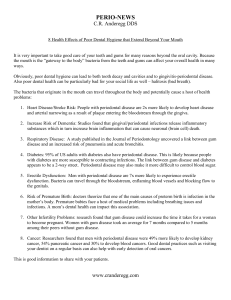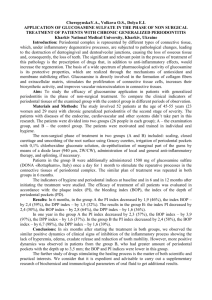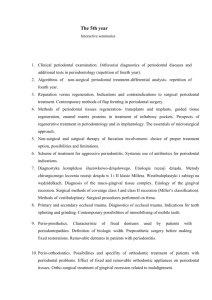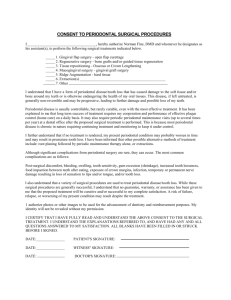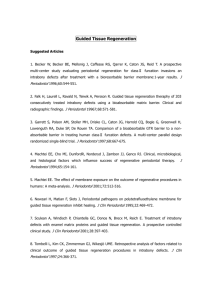Risk Factors - American Academy of Periodontology
advertisement
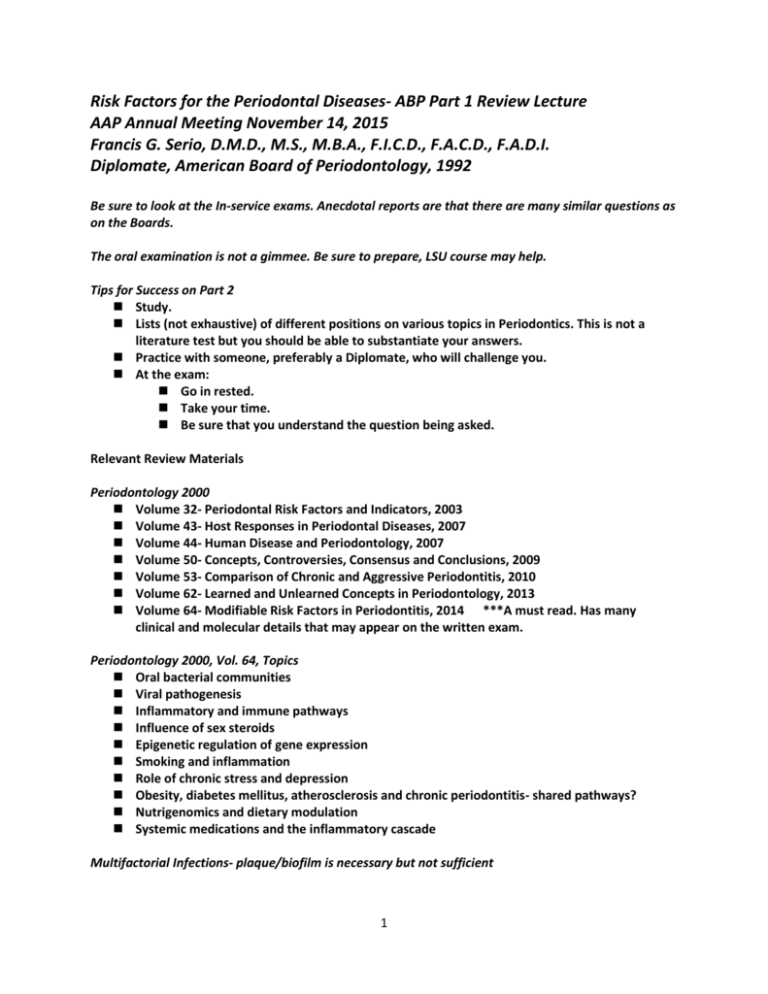
Risk Factors for the Periodontal Diseases- ABP Part 1 Review Lecture AAP Annual Meeting November 14, 2015 Francis G. Serio, D.M.D., M.S., M.B.A., F.I.C.D., F.A.C.D., F.A.D.I. Diplomate, American Board of Periodontology, 1992 Be sure to look at the In-service exams. Anecdotal reports are that there are many similar questions as on the Boards. The oral examination is not a gimmee. Be sure to prepare, LSU course may help. Tips for Success on Part 2 Study. Lists (not exhaustive) of different positions on various topics in Periodontics. This is not a literature test but you should be able to substantiate your answers. Practice with someone, preferably a Diplomate, who will challenge you. At the exam: Go in rested. Take your time. Be sure that you understand the question being asked. Relevant Review Materials Periodontology 2000 Volume 32- Periodontal Risk Factors and Indicators, 2003 Volume 43- Host Responses in Periodontal Diseases, 2007 Volume 44- Human Disease and Periodontology, 2007 Volume 50- Concepts, Controversies, Consensus and Conclusions, 2009 Volume 53- Comparison of Chronic and Aggressive Periodontitis, 2010 Volume 62- Learned and Unlearned Concepts in Periodontology, 2013 Volume 64- Modifiable Risk Factors in Periodontitis, 2014 ***A must read. Has many clinical and molecular details that may appear on the written exam. Periodontology 2000, Vol. 64, Topics Oral bacterial communities Viral pathogenesis Inflammatory and immune pathways Influence of sex steroids Epigenetic regulation of gene expression Smoking and inflammation Role of chronic stress and depression Obesity, diabetes mellitus, atherosclerosis and chronic periodontitis- shared pathways? Nutrigenomics and dietary modulation Systemic medications and the inflammatory cascade Multifactorial Infections- plaque/biofilm is necessary but not sufficient 1 Risk Factors RISK: The likelihood that a person will get a disease in a specified time period. RISK FACTOR: The characteristics of individuals that place them at increased risk for getting a disease. Risk factor is defined as “any characteristic, behavior, or an exposure with an association to a particular disease. The relationship is not necessarily causal in nature…” Garcia, Nunn, Dietrich, 2009 RISK ASSESSMENT: The process of predicting an individual’s probability of getting a disease. RISK INDICATORS: Probable or putative risk factors that have been identified in cross-sectional studies but not confirmed through longitudinal studies. Need a susceptible host- risk factors contribute to, but do not directly cause, the initiation or progression of disease. The Pathogenesis Paradigm From Kornman K. J Periodontol, 2008;79:1560-1568. Local Risk Factors Plaque- biofilm Calculus Anatomic factors Occlusal factors Restorative factors Other factors Plaque/biofilm Socransky Criteria’ Association with disease; Elimination or suppression of the organism results in disease remission; Host response- detection of adaptive immune responses to the organism; Demonstration that the organism is pathogenic in an experimental animal; The organism should possess an array of virulence factors that can be linked to the pathogenesis of periodontal inflammation. Common Periodontal Pathogens Aggregatibacter actinomycetemcomitans Campylobacter rectus Eubacterium nodatum Fusobacterium nucleatum Herpesvirus Peptostreptococcus micros Prevotella intermedia/nigrescens Porphyromonas gingivalis* Streptococcus intermedius Tannerella forsythia (B. forsythus)* Treponema denticola* Current list of suspected periodontopathogens includes 20-30 bacterial species. *- late colonizers- “Red Complex” 2 Concepts of Periodontopathogens Lists of specific bugs. Sometimes use the eradication of a specific bacteria as a primary study outcome- is this valid based on the polymicrobial nature of the infections? Problematic because the bacteria do not act in isolation. Still do not know EXACTLY which bacteria(s) and their relationships initiate and cause progression of disease. Lists of specific bugs. Sometimes use the eradication of a specific bacteria as a primary study outcome- is this valid based on the polymicrobial nature of the infections? Problematic because the bacteria do not act in isolation. Still do not know EXACTLY which bacteria(s) and their relationships initiate and cause progression of disease. Calculus Calculus Composition Calcium Phosphorus Carbonate Na, Mg, K Hydroxyapatite (Ca5(PO4)3 x OH) is major crystal form in mature calculus. Whitlockite is the most common form in subgingival calculus. Also has octacalcium phosphate (Ca4H(PO4)3 x 2H2O), whitlockite (B-Ca3(PO4)2, and brushite (CaH(PO4) x 2H2O). Calculus Mechanisms of Attachment Secondary cuticle (organic pellicle that also calcifies). Mechanical locking into irregularities in cemental surface. Close adaptation of calculus undersurface depressions to unaltered cementum surfaces. Bacterial penetration of cementum (not universally accepted). Mandel- JCP, 1986- Excellent review on calculus. “Subgingival calculus contributes significantly in the chronicity and progression of the disease, even if it can no longer be considered as responsible for initiation.” Greenstein- JP, 1992, JADA, 2000- Comprehensive reviews of scaling and root planing and other aspects of non-surgical therapy. Anatomic Factors Furcation Anatomy Bower RC, J Periodontol 1979;50:23-25 and 1979;50:366-374. 81% of maxillary and mandibular first molars have furcation entrances < 1 mm. 58% of furcation entrances < 0.75 mm. Curette widths range from 0.7-1.0 mm. Cervical Enamel Projections Masters DH, Hoskins SW. J Periodontol 1964;35:49-53. Cervical enamel projections were found in > 90% of mandibular isolated furcation involvements. 3 Restorative Factors Subgingival margins Overhangs Inadequate embrasures Open margins Marginal ridge relationships Root surface caries Overhangs Lang- JCP 1983- debt-ridden dental students- 1 mm overhangs harbored black-pigmented Bacteroides even with good plaque control. Jeffcoat and Howell- JP 1980- the more severe the periodontal disease, the greater the role of the overhang appeared. Brunsvold- JCP 1990- at least 25% of restorations and 33% of patients had overhangs….and he was optimistic!!! Pack- JCP 1990- 56% of restorations had overhangs, 32% of pockets associated with overhangs bled. Jansson- JCP 1994- “The influence of a marginal overhang on pocket depth and attachment loss decreases with increasing pocket depth.” Review Article: Detection of localized tooth-related factors that predispose to periodontal infections. Matthews DC, Tabesh M. Periodontol 2000, 2004;34:136-150. Local Tooth-related Factors Molars Furcations Root trunk length Size of furcation entrance Bifurcation ridges Root concavities Cervical enamel projections Premolar concavities Overhanging restorations Subgingival margins and biologic width Restorative materials Prostheses- TKPs (tooth killing partials). Increased mobility, inflammation, and pocketing around abutments. Crowding Vertical root fractures Mucogingival deformities Adjacent hopeless teeth. Systemic Factors Systemic Disease Overview- Risk Assessment in Clinical Practice Ronderos M, Ryder MI. Periodontol 2000 2004;34:120-135. Behavioral risk factors 4 Smoking Compliance Systemic risk factors Diabetes and glycemic control HIV infection Systemic risk factors Osteoporosis Familial and genetic risk factors Psychological factors Aging Microbiological risk factors Diabetes and Periodontal Disease Diabetes A metabolic disorder in which the body does not produce or use insulin properly Affects approximately 7% of people in the United States—almost 21 million Sixth leading cause of death among Americans Diabetes Type I diabetes Insulin is not created at all Accounts for about 5% to 10% of diabetes cases Requires daily insulin supplementation Type II diabetes Insulin is produced, but used ineffectively Accounts for 90% to 95% of diabetes cases Occurs most often in people who are overweight May or may not require meds Local Inflammatory Reactions and Diabetes Sonnenschein SK, Meyle J. Periodontol 2000, 2015;69:221-254 Cytokine levels in GCF and periodontal tissues- good table reviewing cytokine function. Matrix metalloproteinases (collagen, etc.) in GCF and the periodontium. Reactive oxygen species. Advanced glycation end-products. Altered immune cell function. RANKL and osteoprotegerin. Toll-like receptors. Potential Pathogenic Mechanisms in Periodontally Related Destruction “Expression of RAGE is enhanced in diabetics. AGE-EC RAGE interaction results in a shift to favor clot formation, increased monolayer permeability, and enhanced expression of VCAM-1 and IL-6. Also see increases in IL-1, IL-8, and TNF-a.” E. Lalla 6 Complications of Diabetes Cardiovascular disease Kidney disease Eye complications 5 Neuropathy Foot and skin complications Periodontal disease- Loe- 1993 Periodontal Disease with Poor Diabetic Control Genco Group- Pima Indians which have the highest incidence of Type 2 diabetes, >50% of adults. Found that poorly-controlled diabetics had significantly more attachment loss and bone loss than well-controlled diabetics or non-diabetic controls. Smoking also contributed. Also found that treatment of perio disease may affect metabolic control. Improvement in Glycemic Control with Periodontal Treatment Grossi, et al.- JP, 1997. Found significant reductions in glycosylated hemoglobin in all groups receiving antibiotics as part of periodontal therapy. Kiran M, et al. JCP, 2005. Initial therapy significantly decreased HbA1c levels in patients with periodontal disease. “Diabesity®” What is it, who has it, what can be done about it? Metabolic Properties of Fat Increases levels of C-reactive protein (CRP), a key inflammatory marker. Produces cytokines such as TNF-a, Il-6, and others. Has resident macrophages that proliferate as fat increases. Obesity and Inflammation TNF-a Il-6 Plasminogen activator inhibitor-1 Angiotensinogen Vascular endothelial growth factor C-reactive peptide Health Complications of Obesity Hypertension Diabetes Abnormal blood fats Stroke Osteoarthritis Sleep apnea Cancer Gallstones Gout Cardiovascular disease Poor wound healing Altered inflammatory response Retinopathy Neuropathy Nephropathy Periodontal disease 6 Metabolic Syndrome Central obesity Dyslipidemia Hyperglycemia or diabetes Hypertension HIV/AIDS An Update on HIV and Periodontal Disease Ryder MI. J Periodontol 2002;73:1071-1078. HAART therapy- highly active antiretroviral therapies- reverse transcriptase inhibitors and protease inhibitors- viral loads may decrease to undetectable levels. With HAART, atypical HIV-associated oral lesions have decreased by 30%. Necrotizing disease suggests low CD4 counts. HIV patients have more AL than healthy patients. Periodontal treatment has not changed in 15 years. HIV-infected individuals may exhibit the following: Linear gingival erythema Necrotizing ulcerative gingivitis/ periodontitis Severe localized periodontitis Severe destructive necrotizing stomatitis affecting gingiva and bone San Giacomo, et al. OOOO, 1990; Williams, et al. OOOO, 1990; Winkler, et al. 1996; Winkler, et al. JADA, 1989. Hormone-related Periodontal Disease Influence of sex hormones on the periodontium Mascarenhas P, Gapski R, Al-Shammari K, Wang H-L. J Clin Periodontol 2003;30:671-681. Hormonal Influences Mealey BL, Moritz AJ. Periodontol 2000 2003;32:59-81. Primarily estrogens and progestins affect gingival tissues. See selective overgrowth of P. intermedia by substituting estradiol and progesterone for menadione. Pregnancy gingivitis in 30-100% of pregnant females and 10% develop pyogenic granulomas. Sooriyamoorthy and Gower. JCP 1989;16:201-208. A good review. High counts of B. intermedius (P. intermedia) have been observed in users of oral contraceptives and in the 2nd trimester. This is due to the competitive binding of progesterone and naphthaquinone, an essential nutrient for bacterial growth. See increased P. intermedia counts and pseudopockets, rather than attachment loss. Stress- Psychosocial Factors Warren, KR, et al. Role of chronic stress and depression in periodontal diseases. Periodontol 2000 2014;64:127-138. Stress and Depression Psychoneuroimmunology- psychological stress as a co-factor in disease. Genco- financial strain and inadequate coping style. Chronic stress- a state of inflammation. 7 Depression also elevates serum markers of inflammation. Boyapati L, Wang H-L. The role of stress in periodontal disease and wound healing. Periodontol 2000, 2007;44:195-210. Medications and Their Effects on the Periodontium Dongari-Bagtzoglou A. Drug associated gingival enlargement. An AAP Information Paper. JP 2004;75:1424-1431. A MUST READ! Over 20 drugs cause enlargement. Prevalence info difficult to get- current thinking- phenytoin 50%, nifedipine 6-15%, CsA 2530%. Enlargement of CT, collagen and ground substance. More fibroblasts controversial. Mechanism poorly understood. Fibroblasts react to IL-1B. Recurrence rate of overgrowth about 40%. Medications Phenytoin Nifedipine, other calcium channel blockers Cyclosporin A Tacrolimus- (Prograf®)- 14% of subjects may have gingival overgrowth. (Sekiguchi, et al. 2007) Medications- Cyclosporin A Acts solely on cell-mediated immunity Resembles phenytoin overgrowth clinically and histopathologically, is seen in 30% of recipients, related to serum concentration of drug- Seymour, et al. JCP, 1987. Combination of nifedipine and cyclosporin shows greater overgrowth than cyclosporin aloneEllis, et al. JCP, 1999. Alani A, Seymour R. Systemic medications and the inflammatory cascade. Periodontol 2000, 2014;64:198-210. Steroids- good and bad- as medication, beneficial. As a result of stress (cortisol)- destructive. Cox-1 and Cox-2 inhibitors- have anti-inflammatory and perhaps anti-PD properties but may interfere with resolution molecules (Van Dyke). Low dose ASA and omega- 3 FA may have salutary effect on PD. (El-Sharkawy, et al. J Periodontol, 2010;81:1635-1643) Calcium Channel Blockers and Gingival Overgrowth Dihydropyridines Nifedipine (Adalat®, Procardia®)- 10-15%- often reversible with d/c of drug. Almost 80% of all CCB overgrowth reported cases. Others (amlodipine- Norvasc®)- yes Others- rare overgrowth Diltiazem (Cardizem®) Verapamil (Calan®) Bepridil (Vascor®) 8 Medications- Membrane-ion channel blockers Calcium-channel blockers- influence fibroblasts to overproduce collagen matrix and ground substance when stimulated by gingival inflammation- Ellis, JP, 1999. No link with periodontitis. Similar to phenytoin overgrowth- Bullon, et al. OOOO, 1995. Genetics as a Risk Factor Genetics Terminology Heritability- the proportion of phenotypic variation within pairs attributed to genetic variation. A heritability estimate of 50% means that one half of the variance in the population is attributable to genetic variance. It does not mean that 50% of offspring of affected parents will be affected. Need large samples of reared together twins to estimate heritability accurately. Heritability estimates for MZ twins is about 50%. Michalowicz- JP, 2000- Looked at MZ and DZ twins. Calculated that adult periodontitis had a 50% heritability (half of the variance in disease in the population is attributed to genetic variance) Kinane DF, Shiba H, Hart TC. The genetic basis of periodontitis. P2000 2005;39:91-117. Among other things, questions the utility of IL-1 testing. Useful in only 30% of Europeans, 2.3% of Chinese, and low in African-American populations. Very good review. Tobacco Use and Periodontal Disease Smoking may be the most important environmental risk factor for periodontitis. Bergstrom, Palmer, Ryder, Stabholz Bergstrom, Preber Group- Several studies in JCP from 1987-2005. With other factors controlled for, found smokers had more bone loss than nonsmokers. One study was done in a group of dental hygienists with a high degree of oral hygiene. Also found that smoking affected therapy, causing less probe depth decrease. This was more evident after scaling the maxillary anterior segment. Rate of bone loss slows once a patient stops smoking. More calculus found in smokers- dose dependent. Smoking and inflammation: evidence for a synergistic role in chronic disease. Johanssen, et al. Periodontol 2000, 2014;64:111-126. Significant increases of periodontopathogens in smokers. Negative impacts on leukocytes. Significant decrease in humoral immunity, esp. decreases in IgG. Impaired fibroblast function. Possible gene-smoking interactions- may be related to Il-1B and leukocyte function. Cigarette Smoking and the Periodontal Patient- A State of the Art Review Johnson GK, Hill M. J Periodontol 2004;75:196-209. Strength of association- cross-sectional and case-controlled studies demonstrate a moderate to strong association between smoking and periodontitis Consistency- multiple studies of various designs have demonstrated this association 9 Specificity- disease progression slows in patients who stop smoking compared to those who continue to smoke Temporality- Longitudinal studies show that smokers do not respond as well to periodontal therapy as non-smokers Biologic gradient- there is a dose-response effect in that heavy smokers have increased disease severity compared to light smokers Biologic plausibility- supported by tobacco’s negative effects on microbial and host response parameters Coherence- the effects of smoking on periodontitis are consistent with our knowledge of the natural history of periodontal disease Analogy- periodontal effects of smoking are analogous to other adverse smoking-related general health effects Experiment- evidence not currently available Overlap of risk factors leads to an increasing susceptibility to periodontitis. Genco Group- 5 Major Factors Age Smoking* Uncontrolled diabetes* Bacteroides forsythus (Tannerella forsythia) Porphyromonas gingivalis **The double whammy!!! Periodontitis as a Risk Factor for Systemic Disease Medical Conditions Related to Periodontal Disease Cardiovascular disease Pre-term low birth weight infants Rheumatoid arthritis Diabetes Pneumonia Is it causality, contributory, or coincidence??? Hill’s Criteria to Accept a Causal Relationship Biological plausibility Consistency of associations Strength of the association Temporal consistency Specificity of the association Consistency of the findings Dose-response effect Support from experimental evidence Calculating Odds Ratios For example: If the incidence of oral cancer in a smoking population is 0.002 and in a nonsmoking population is 0.0004, the odds ratio is 0.002/0.0004 = 5 10 Odds ratio >1 indicates a positive association, <1 a negative association, and =1 no association. When is an odds ratio meaningful? 11

